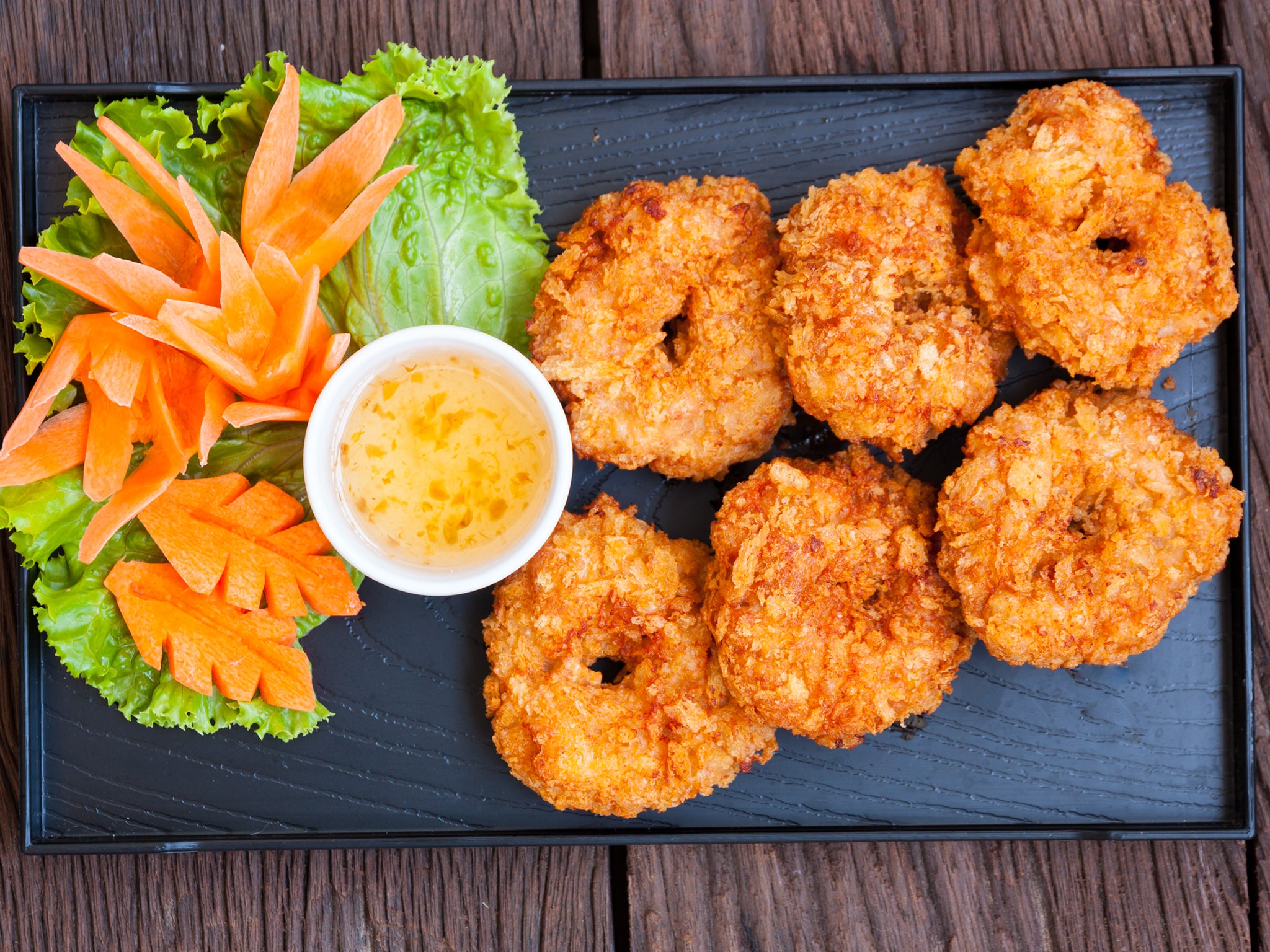The secret ingredient for the crispiest, lightest batter
Melissa Clark uses something unusual for an extra boost of flavour... and it’s gluten free too

Whether bite-size Thai prawn patties spiked with fish sauce, Vietnamese shrimp paste packed onto sugar cane or southern American prawn burgers shot through with mayonnaise, savory prawn cakes are a tasty staple in coastal regions all over the world.
Unsurprisingly, their flavours vary depending on where they’re made. You’ll find them spiced with the likes of white pepper in China, chillies in Latin America or Old Bay seasoning in South Carolina.
Another point of difference is the binder – or lack thereof. Some traditional recipes skip it, mashing and pounding the prawns until they stick together on their own. This results in a firm, bouncy texture after cooking, with a pleasing chew. Other recipes lace some combination of eggs, flour, cornstarch, bread or cracker crumbs, or rice into the prawn batter, making for airier, crumblier cakes that are easier to brown when cooked at high heat (usually deep-fried, pan-fried or grilled).
In my somewhat untraditional rendition, I’ve bound the batter with something else entirely: crumbs pulverised from puffed, crunchy rice cakes.
Although this may not seem intuitive, it does make sense, given that both rice and crackers are common binders. Rice cakes just combine the two. You get the mild flavour and gluten-free qualities of the rice along with the crispness of crackers.
Make sure to use the pebbly kind of rice cakes here (either thick or thin), the ones that vaguely resemble popcorn or plastic foam. While you could crush up smooth, waferlike rice crackers for this, the prawn cakes won’t be quite as airy. The beauty of the rice cakes is how all that air trapped in the puffed rice gives the prawn cakes a lighter, more ethereal texture.
To make the crumbs, grind the rice cakes in a food processor or blender. Then, the prawns and aromatics (I use a bracing mix of garlic, basil, coriander and chillies) can be whirled together in the same container, no need to wash it first.
Chilling the batter for at least an hour (or overnight) makes it easier to form into cakes. And the fried cakes freeze reasonably well, although they won’t be as crisp after thawing. Running them under the broiler helps restore them.
I like to serve these with an herby, chilli-flecked mayonnaise that’s sort of like a tartar sauce, but spicier. Then, I nibble them hot from the pan and dream of the beach.
Crispy prawn cakes with chilli-lime mayo
By: Melissa Clark
Serves: 3 to 4
Total time: 45 minutes
Ingredients:
3 to 5 large original or lightly salted rice cakes, or 6 to 10 thin cakes (see tip)
450g shelled large raw prawns (20 to 24), coarsely chopped
40g minced shallot (or use onion or spring onion)
6 tbsp chopped coriander
6 tbsp chopped basil leaves, more for serving
3 tbsp minced jalapeño or red chilli pepper
2½ tsp fish sauce
Fine sea salt and freshly ground black pepper
120g mayonnaise
1 lime
Safflower, peanut or grapeseed oil, for frying
Method:
1. In the bowl of the food processor (or you can use a blender), add the rice cakes and pulse until you get 125g rice cake crumbs. Return 25g crumbs to the food processor, reserving the remaining 100g for coating the cakes.
2. Add prawns, shallot, 4 tablespoons each of the coriander and basil, and 2 tablespoons jalapeño to the crumbs. Add 2 teaspoons fish sauce and a pinch each salt and pepper. Pulse until the mixture forms a coarse, chunky paste. (Be careful not to overprocess; if using a blender, scrape down the sides frequently.) Transfer to a bowl, cover and refrigerate while you make the sauce (at least 15 minutes and up to 24 hours).
3. In a small bowl, whisk together mayonnaise, remaining coriander, basil, jalapeño and fish sauce. Zest the lime into the bowl, then cut the naked lime into wedges and squeeze in some juice. Salt to taste. Reserve extra lime wedges for serving.
4. Spread remaining 100g rice cake crumbs out onto a plate or baking tray. With wet hands to keep paste from sticking, form 2 tablespoons of prawn mixture into a 1.5cm-thick patty and put it on top of the crumbs. Repeat with remaining prawn mixture, re-wetting your hands as necessary. Turn the patties over in the crumbs to coat both sides.
5. Heat oil in a large frying pan over medium-high. Fry patties in batches until golden brown, 3 to 4 minutes per side. Serve prawn cakes topped with more basil leaves, with chilli-lime sauce for dunking and lime wedges on the side for squeezing.
Tips: Original, whole grain or brown rice cakes (either the thick or thin kind) all work well here. If you can’t find rice cakes, use 125g panko or cracker crumbs instead. The cakes won’t be quite as crisp, but they will still taste great.
And to drink...
The combination of herbs, pungent fish sauce and chilli heat, along with the mild prawn flavour of these cakes, would put me in the mood for aromatic, herbal whites with racy acidity and minimal oak flavouring. Austrian grüner veltliners, German rieslings (dry or sweet), restrained sauvignon blancs – all of these would be terrific with this dish, just as they would be with many southeast Asian preparations. Other options might be light-bodied Italian whites like Ligurian vermentinos, albariños from the Galicia region of Spain or breezy whites from Savoie in France. I wouldn’t choose a red, but if you insist, look for fresh, delicate examples like Valpolicella Classicos, Jura poulsards and maybe inexpensive, unoaked Loire reds, which often go well with Vietnamese or Thai dishes.
Pairings by Eric Asimov.
© The New York Times
Join our commenting forum
Join thought-provoking conversations, follow other Independent readers and see their replies
Comments
Bookmark popover
Removed from bookmarks